|
| |
Although Calcutta's official birthday is August 28, 1690,
the city's environs date back to nearly two thousand years ago, when Tamralipti,
now known as Tamluk, was a thriving port of the Gupta Empire, trading with the
whole of South East Asia. Tamralipti was the starting point of the southwestern
silk route that passed through Bengal and Assam and Burma before ending in the
Yunnan province of China. After the decline of the Gupta Empire, Bengal was
ruled successively by the Pala and Sena dynasties. Tamralipti, the center of all
maritime activity of a kingdom that thrived on foreign trade, continued to
develop into a cosmopolitan city. Tamralipti's decline began after Bengal fell
to the Sultanate of Delhi in the twelfth century. The new ruling class from
Central Asia obviously had little exposure to the sea and was poor seafarers. In
spite of the decline, Tamralipti survived at least until the fifteenth century,
the Ming Emperor's fleet led by Admiral Zheng He, called on Tamralipti, in order
to strengthen trade relations with Bengal. By the sixteenth century Tamralipti
was subject to excessive silting and the new traders from Europe began seeking
other sites.
|

A gold coin of the Gupta Empire, that was
used as an instrument of international trade at the port of Tamralipti. |
Tamluk has silted over the centuries and is no longer an
active port. There are plans to dredge the river and reopen Tamluk to the
maritime world, but until then the oldest version of this great city remains a
sleepy little town.
In 1537, the Portuguese sailed up the Ganges to establish
their settlement in Satgaon. In 1580, they moved to a new settlement called
Bandel de Hooghly. In 1599, the Portuguese consecrated the Church of Our Lady of
Happy Voyage. The Portuguese colony was short-lived. The Portuguese had flouted
their agreement with the Mogul Empire and had engaged in slave trade, had
fortified their territory and were supplying arms to the Arakan Kingdom that was
at war with the Moguls. Emperor Shah Jehan attacked and destroyed Bandel de
Hooghly in 1632 and all survivors were imprisoned. A change of mind of the
Emperor led to the release of the prisoners a year later and permission was
granted to rebuild the settlement. However, Bandel never revived much except for
the church. The church was already a pilgrimage for Christians, Hindus and
Moslems alike, at the time of the attack, and continues to do so. The church is
now a Basilica and a major center of the Roman Catholic religion in South East
Asia.
|

The flag of the Kingdom of Portugal might
well have been the first European ensign to fly in what is today the
metropolitan area of Calcutta |
One of the main reasons for Bandel's decline was the
competition by other European nations and their trading companies. In 1625
Vereenigte Oostindische Companie of Holland, more commonly known as the Jan
Companie, established a settlement at Chinsurah a few miles south of Bandel to
trade in opium, saltpeter, muslin and spices. They built a fort called Fort
Gustavius and a church and several other buildings. A famous Frenchman, General
Perron who served as military advisor to the Mahrattas, settled in this Dutch
colony and built a large house here. The Dutch settlement of Chinsurah survived
until 1825 when the Dutch in their process of consolidating their interests in
modern day Indonesia, ceded Chinsurah to the English in lieu of the island of
Sumatra. Fort Gustavius has since been obliterated from the face of Chinsurah
and the church collapsed recently due to disuse, but much of the Dutch heritage
remains. These include old barracks, the Governor's residence, General Perron's
house, now the Chinsurah College and the old Factory Building, now the office of
the Divisional Commissioner.
|

The arms of the Dutch East India Company. |
|
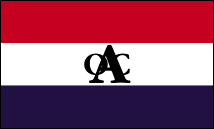
The flag of the Dutch East India Company
that once flew over Chinsurah and Baranagore. |
|
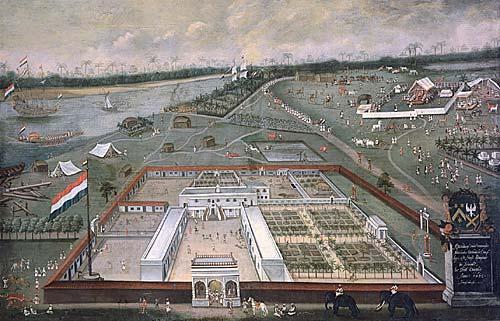
A picture depicting the Dutch factory at
Chinsurah, dated 1665. |
|
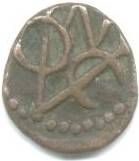
A coin struck by the Dutch East India
Company for use in Chinsurah, dated 1690. |
The French established their colony at Chandernagor in
1673. Until the middle of the next century, Chandernagor rivaled Calcutta in its
trade. The wars between the English and French were reflected thousands of miles
away in the waters of the Ganges, too. Chandernagor was a heavily armed French
garrison as was Calcutta for the English. The French built the Fort d'Orleans
amongst a number of other buildings. Chandernagor's history reflects the
upheaval of Europe during the seventeenth and eighteenth centuries. In the
course of these wars, Chandernagor was taken by the British twice between 1757
and 1763 and then again between 1794 and 1815. Chandernagor was the sourcing
point for opium for the French and supported more than half of the finances of
French Indo-China. Chandernagor remained a French colony until 1949 when a
referendum led to its merger with the Republic of India. Chandernagor was a
favorite spot for rich Calcuttans during the first half of the twentieth century
for French food and wine, duty-free. Chandernagor's French aura remains even
after almost fifty years since the departure of the last Adminsitrateur. A gate
with the motto of the French Republic "Liberte Egalite Fraternite"
marks the entrance to the former Etablissment de Chandernagor. The quai Dupleix,
Chandernagor's waterfront road is lined with shady trees and public benches,
replicas of the ones in Parisian parks. The former Administrateur's eighteenth
century mansion is now a museum of French heritage in Chandernagor. The former
Hotel de Paris, the Couvent Saint-Joseph and Rabindranath Tagore's house are
amongst the many heritage buildings that line the quai Dupleix. Behind the
Administrateur's residence stands the Eglise du Sacre Coeur, reminiscent of
French village churches with a statue of Joan d'Arc and a Lourdes grotto. On the
Rue de Paris, to the north of the town is the French cemetery with more memories
of the colonial age.
|
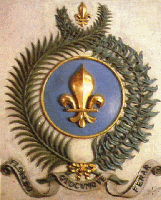
The coat of arms of the French East India
Company. |
|

The flag of the French Colonies that flew
over the French Administrateur's residence in Chandernagor until 1949. |
|
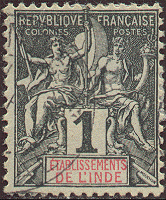 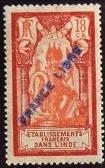 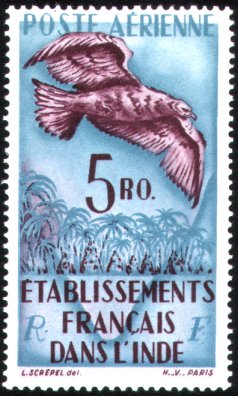
Three stamps of the French
"Establishments" of India (from 1893, 1929 and 1949 respectively)
and affixed to letters mailed from Chandernagor. |
|
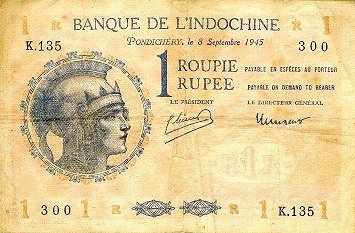
A 1-"Roupie" note issued by the
Banque de Indo Chine in 1945. This money was legal tender in Chandernagor
until 1949. |
|
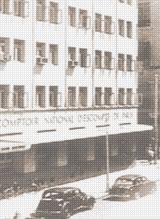
A 1935 picture of the Comptoir National
d'Escompte de Paris on Dalhousie Square in Calcutta. This organization, which
continues today as BNP Banque Paribas, opened shop in 1860 at the same
location. The fact that it opened in the city rather than in the French
enclave of Chandernagor only a few miles away, indicates that Calcutta had
taken over Chandernagor as the center for trade with France by that time.. |
|
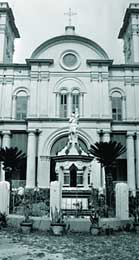
An old picture of the Eglise du Sacre
Coeur, French for Sacred Heart Church, where the French atmosphere lingers on
to this day. |
|
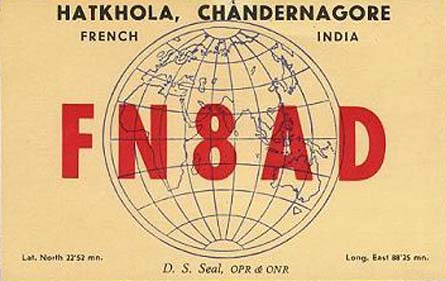
A 1949 reception report card of the
French radio station at Chandernagor. |
The Danish East India Company established a colony called
Fredericknagore, in honor of King Frederick the Fifth near Serampore in 1699.
Occupied twice by the English during with their war with Denmark,
Fredericknagore failed as a commercial venture. In 1777, after the Danish
company went bankrupt, Serampore became a Danish crown colony. Serampore's
commercial failure was complemented by its immense success on the cultural
front. As the English did not permit missionary activities in their territories,
Serampore became a safe haven for missionaries in India. In 1799, Reverend
William Carey and two fellow Baptist missionaries established the first printing
press in Asia, here in Serampore and began printing copies of the Bible. In
1819, Carey went on to establish the Serampore College, the first institution of
western higher education in Asia. In 1827, a Royal Charter by the King of
Denmark incorporating it as a university at par with those in Copenhagen and
Kiel. In 1845, Denmark ceded Serampore to Britain ending the nearly 150 years of
Danish presence in Bengal. Serampore's Danish heritage lingers to this day.
Serampore University's massive 1821 neo-classical building now serves as a
Baptist theological institute and a museum on the life of William Carey. The
mansions built by wealthy Danish families on the waterfront, the St. Olaf
Church, Royal Danish Army barracks and the cemetery stand testimony to
Serampore's Danish heritage to this day.
|
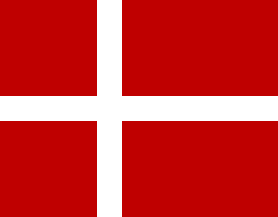
The Danish flag that was the ensign of
the colony of Serampore and the guardian of wisdom until it was replaced by
the Union Jack. |
Before Chinsurah became a Dutch colony, it was already home
to Calcutta's oldest expatriate community. Armenians arrived here in the
sixteenth century and settled this town. Their interests, however, were more
local than their Dutch counterparts. They settled permanently in Chinsurah as
traders, quite unlike the Dutch who remained predominantly sailors. The
Armenians funded the English East India Company to build Calcutta and moved to
this city where they continue to live to this day. However, the Armenians
continue to gather at the old Armenian church in Chinsurah for the celebration
of the festival of St. John the Baptist, their patron saint, in the last week of
January.
The most short-lived venture was taken up by the Ostend
Company. Flanders (present-day Belgium) ended up under the rule of the Holy
Roman Emperor as part of a settlement to one of the wars of succession in
Europe. Traders in the port of Ostend appealed Emperor Charles VI for a charter
and the Ostend Company was established in 1719 with the express intent of trade
with Bengal. A factory was established at Banquibazar in 1723. The trade was
very successful, but British and French pressure caused the Emperor to withdraw
the charter to be withdrawn in 1727. Ostend Company was liquidated in 1731 but
Flemish traders continued to run the colony until 1744 when they abandoned it to
move to Calcutta.
|
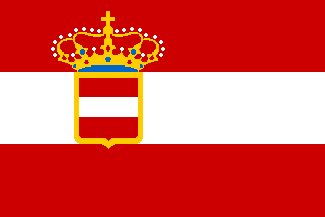
The flag of the Ostend Company that
represented Flemish interests in Bengal for about 20 years in the 18th
century. |
|
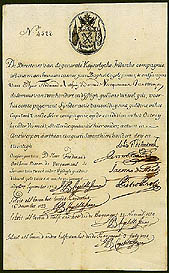
A share of the Ostend Company. |
The number of nationalities who ventured into the area that
would eventually become the city of Calcutta was many. Greeks established a
colony in Rishra, Prussians in Bhadreshwar, not to mention the second Dutch
colony at Baranagore, mainly a port and loading dock for the Dutch ships. With
the rapid development of Calcutta, these colonies wound up and their residents
moved to the city and continued to contribute to its growth.
The small European colonies that dotted the banks of the
Ganges, ended up in the great cosmopolis of Calcutta, once a tiny hamlet that
chance directed to be the second city of an empire on which the sun never set,
at least for a fairly long period in time.
|